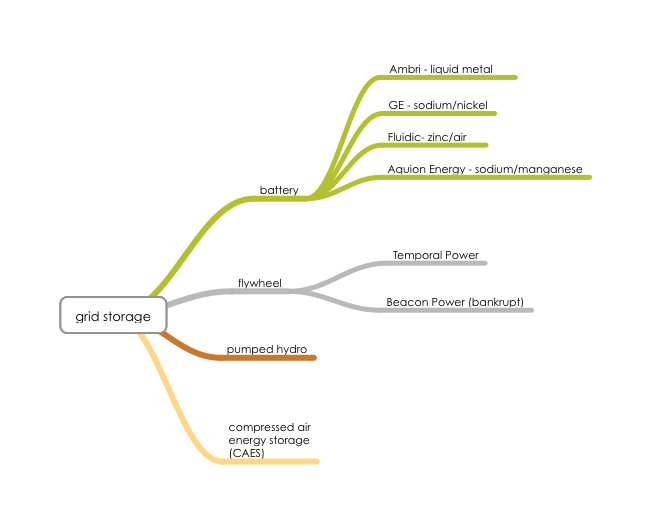grid storage part 4: the tree grows
The grid storage eco-system that was presented on February 26th has been filled out a bit. In particular Aquion Energy, GE and Fluidic Energy have been added to the battery branch. The updated tree is presented below.
The grid storage eco-system that was presented on February 26th has been filled out a bit. In particular Aquion Energy, GE and Fluidic Energy have been added to the battery branch. The updated tree is presented below. Acting as a quick reference of grid storage technology the tree is designed to indicate who is there and how they fit into the broader grid storage eco-system. At this level the technology of each battery “entrant” is only roughly identified.
When digging deeper into the technology the basic benchmark of both cost and performance appear to be lead-acid batteries. When developing new systems one would like to approach the cost of lead-acid, but achieve much higher levels of performance. How do we get these higher levels of performance? One can readily appreciate important areas of development include, electrodes, electrolyte and packaging. In the case of GE and Ambri, which operate at elevated temperatures, packaging and overall structure are particularly important for reasons of thermal management. One can also see specific areas of the technology that were developed to enable the overall system. In the case of GE the ceramic electrolyte of their system comes to mind.
Finally, the case of Fluidic Energy is an interesting one. A recent article highlights their zinc-air battery. In particular the article describes two areas of focus. The first is a system and/or method to ensure or improve the state of the zinc when it is returned to its metallic form. In particular the reduction of ZnO apparently creates a porous structure that includes dendritic grain growth. A second issue is the endurance of the air electrodes. The article does not go into details of how these are addressed, however a number of published patent applications at the USPTO have proven to be interesting reads.
In the end. there are several levels at which the grid-storage eco-system can be considered. At a high level there is utility in organizing the entrants to see how they fit. There is however another level on the technology front. Here we can consider what areas need to be fleshed out to enable the technology. At the same time we can see how the corporate entrants are protecting any developed Intellectual Property. As not all problems are created equal there will be differences in how and when systems are brought to market based on success or failure of addressing these enabling bits of technology.



